Coralie Condon gently passed away at 7am on Christmas Eve 2014, aged 99, at the Castledare Retirement Village, in Wilson. Once the site of the Castledare Boys Home and still the location of the Castledare Miniature Railway.
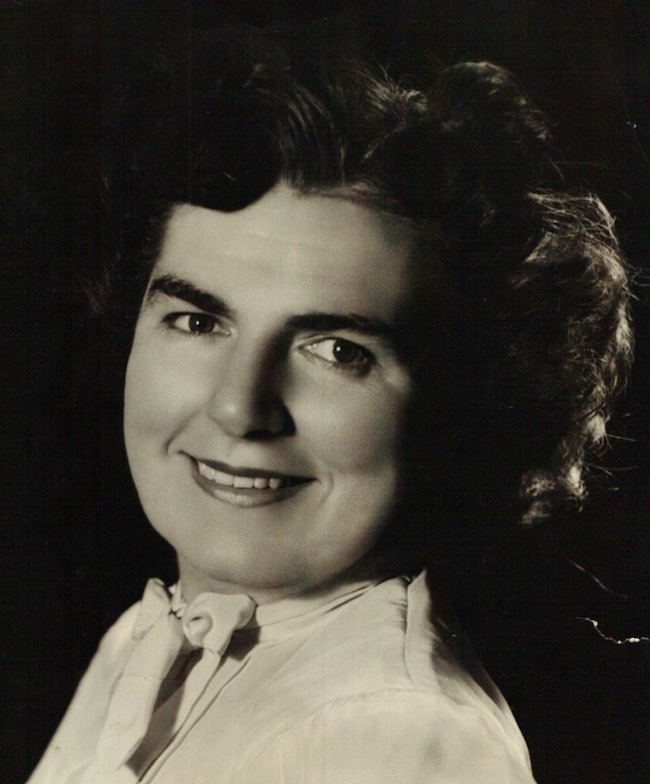
Coralie was an actress, writer, composer, producer, presenter, business woman, the Grande Dame of Perth theatre and the First Lady of Western Australian Television.
Much of the following is based on Coralie’s reminiscences, those also of her close friends and a paraphrasing of the many newspaper reports and critiques by such non de plumes as ‘Thespis’ and ’Fidelio’ of The West Australian, and social happenings from ‘Priscilla Pepys Prattle’ and ‘Molly’s People & Parties’ of the Mirror, and many articles by anonymous authors.
Accounts of the Repertory Club performances come from Chris McMaster who wrote under the pen-name ‘Thespis’ and Albert Kornweibel (1892-1980) whose newspaper persona was ’Fidelio’.
Coralie Grace Condon was born on May 16, 1915, at Nurse O’Grady’s Maternity Home, 156 Mandurah-road, South Fremantle, to Mr. and Mrs. T. J. Condon.
Her parents, Thomas Joseph Condon, a bookkeeper, and his wife, Ruby Valentine (nee Sweeney), a coloratura soprano, loved the theatre and immersed their three children in every aspect of it, from performing to painting the scenery. Her mother also conducted the choir at St. Patrick’s Church, whilst her father was vice-president of the South Fremantle Football Club.
St. Patrick’s Church is now the Basilica of St Patrick’s, where Coralie’s Requiem Mass will be celebrated in Adelaide-street, Fremantle, commencing at 10:00am on FRIDAY (23.01.2015).
Coralie’s father worked at the State Implement Works, at 101 Thompson Road, North Fremantle. The department was started on January 1st, 1901, with C.Y. O’Connor (1843-1902) as the Engineer in Chief. It was the State Government Agency of Western Australia, which was charged with providing and maintaining public infrastructure such as dams, water supplies, schools, hospitals, harbours and other public buildings.
C.Y. O’Connor was responsible for the construction of Fremantle Harbour and the Goldfields Water Supply Scheme project, which supplied water to the Eastern Goldfields, before becoming the inaugural Engineer in Chief of what became the Public Works Department. Sadly, O’Connor committed suicide less than a year before the Goldfields Water Supply Scheme was officially commissioned. This was after much unfair criticism that claimed the project would fail. It proved to be a great success.
The Condon family residence for most of Coralie’s childhood was 170 Ellen street, Fremantle, where they lived on the top of a large hill located between Monument Hill and another nameless one. The street numbers were changed in 1935/36, though the house could be found behind the former Girton College girls’ school, a venue for musical events that Coralie participated in. This took place in a Gothic building that still survives at 200 High Street, Fremantle. Coralie pointed this out to her friend, former broadcaster and historian Colin Nichol.
Ellen Street was named for Ellen Mangles of Woodbridge, Surrey, England, wife of Sir James Stirling, who persuaded the British Government to establish the Swan River Colony, to which he became the first Governor and Commander-in-Chief of Western Australia.
Much of Coralie’s pre-teenage childhood was during the silent movie era, when vaudeville was still very much in fashion and people entertained each other in the home, singing and playing instruments.
Entertainment places of influence around Fremantle would have been: Victoria Hall in High Street, which had a long history as a live venue right up until the modern day, as was the Town Hall and Kings Theatre in South Terrace (now the venue of the Metropolis Nightclub). For the city was well served with not only live events, but also early moving picture houses such as the Majestic, the Princess, and Palladium. Meanwhile, some of the popular Perth vaudeville venues were the Luxor (1925), the Ritz (1934) and the Tivoli (1940s), all at the same location cornered by Beaufort, James and Stirling Streets, over the railway line, which was also to be the site of the Canterbury Court Ballroom, next to the Shaftesbury Hotel.
Coralie’s mother died on September 29, 1928, at the age of 41, leaving Coralie as a young teenager to assist with supporting her younger sister Beryl (1918-2011) who the family called Terry, and brother James (1923-2014). It was also a time when Coralie was trying to win a school scholarship.
It should be noted that Coralie’s mother was a friend of the Australian speech and language therapist and stage actor Lionel Logue (1880-1953), who treated King George VI’s stammer. Logue’s professional career began in Perth. When the 2010 movie titled “The King’s Speech” was released, Coralie pointed this friendship out to close friend and confidante Audrey Long. Geoffrey Rush played Logue in the movie.
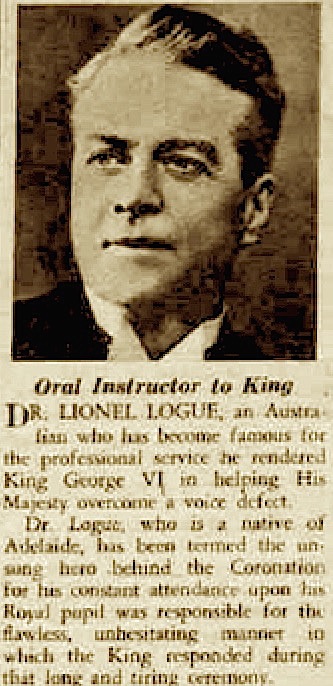
Coralie and Beryl both attended the St. Joseph’s Convent, in Fremantle (demolished c1968), which at that time was located next to St. Patrick’s Church. Both girls studied music with Coralie concentrating on the piano and Beryl the violin. Coralie went on to play piano for the Fremantle Orchestral Society (which became the Fremantle Musical and Dramatic Club in 1941).
Over a number of years, she was to keenly study not only singing and piano, but also the art of speech.
At 15 years of age, Coralie passed her Junior Certificate in January 1930, with seven subjects English, French, German, Geography, Mathematics 1 & B and Music. The same year, she achieved Grade I Honours in a Music examination conducted under the auspices of the university. Beryl was also excelling and won a best essay from school children on “Why Western Australian Products Should Be Used” in May 1931. Professor Walter Murdoch, of the University, made the final choice.
Whilst Coralie was in her teenage years, Australia suffered badly during the Great Depression of the 1930s, and it required the industrial effort of the second world war to stimulate the economy. Fortunately, Coralie’s father was in the public service, which provided a buffer for the family during a period of high unemployment, where people lost their homes, and there was a great shortages of goods.
It was a time when the racehorse Phar Lap dominated Australia’s horse racing scene and the cricketer Don Bradman wrote his name into the record books. Sound movies arrived, as more wireless stations appeared on the radio dial. There was also a growth in gramophone record sales.
But all was not grim for Coralie, for in 1932, the Parents and Citizens Association organised a trip to Melbourne for her and a group of fellow schoolgirls. A tour that involved attending concerts, both during and after Coralie’s return. It was the same year she passed English, French, Mathamatics A and Music in her Leaving Certificate examination. Following this she passed the Alliance Francaise examination in French.
In 1933, she passed a Shorthand examination at 80 words per minute. The same year she passed English and French whilst working towards her Bachelor of Arts.
In 1934, at 19 years of age, Coralie qualified in an examination for female telephone exchange operators. Coralie was also making regular appearances in the social pages of the newspapers for either entertaining at or participating in a variety of parties.
In 1935, Coralie passed with credit in the practical examinations in music conducted at the University of Western Australia, under the auspices of the Australian Music Examinations Board.
In 1936, aged 21, Coralie participated in a three-act comedy, “Take Two from One,” produced by Miss Ethel Gordon, and given by her pupils at the Swan-Suburban Theatre, East Fremantle, in the presence of a large audience. Then she passed her Art of Speech examination.
By 1937, it is common for Coralie and her sister Beryl to join their aunty Miss Grace Sweeney in entertaining at various functions, usually in honour of a bride to be.
In 1938, aged 23, Coralie was entertaining at meetings of the Fremantle Musical and Dramatic Club at The Rendezvous in Fremantle and the same year passes with a Grade 1 Credit in University practical music examinations.
Coralie spent the year in Melbourne during 1939, in which she confided that, “We became mad first-nighters and rushed about going to every show that was on. The person I stayed with had been a concert artist and it seemed the natural thing to do.”
By 1941, Misses Coralie and Beryl Condon were entertaining at their flat at 22 St. George’s-terrace, Perth, where they had moved with their father and brother James, until he joined the air force. Their father took the girls regularly to plays at the Repertory Club.
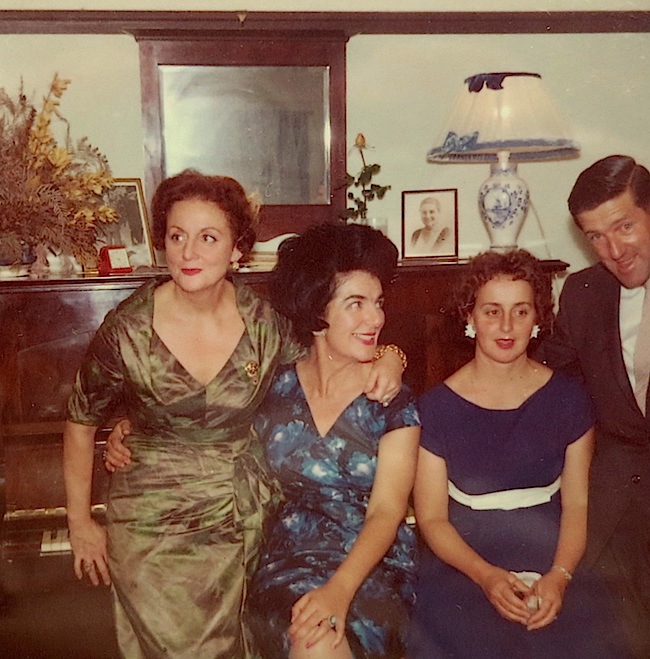
It was a time when music tastes in the community were changing, with the big show-band music of Benny Goodman, Glenn Miller, Tommy Dorsey, Guy Lombardo and others. Overseas music stars who started their career singing on the stage and radio where being seen on the big screen. Many films depicted Broadway as the musical genre carried over into the movies. There were so many more influences to inspire young talent wishing to participate in the entertainment field than ever before.
At 27 years of age, Coralie joined the Repertory Club in 1942, and was given her first part, a minor one during May of that year in “Her Shop”. Her brother James was also in the cast; then in July she stepped straight into character work, playing at extremely short notice, the inebriated elderly spinster in “Ghost Train.” Since then there were a number of parts, including many camp concerts and shows during the war and the production of several one-act plays and sketches, while she was often heard in radio plays with brother James Condon at the ABC. James was only 18 when he joined Coralie in repertory theatre that year, and joined ABC Radio. It was also the year James enlisted in the RAAF.
In October of 1942, the Repertory Club presented the Drama Festival prize-winning play, “Morning Sacrifice,” set in the staff room of a secondary school. The star was Dorothy Krantz with Coralie promoted to a small acting part opposite her. This was the beginning of an association between the two that resulted in a life-long friendship.
In 1943, the three-act comedy, “Family Affairs,” featured Rick Hearder’s mother Beryl in the cast and a swath of actors including 6PM’s John Luke and Coralie Condon. Beryl’s husband Kirke was a Supervising Engineer with the PMG Telephone branch. A government department that also employed Coralie. Mr. Kirke Hearder was the electrics expert who installed all the lighting at the Repertory Theatre and was in charge of lighting during performances. He was also the stage manager and acted when needed. It was around this time, and through his mother, that the young Rick Hearder became friendly with Coralie, who was fifteen years his senior. This too resulted in a life-long friendship for the pair. Part of the proceeds from “Family Affairs” went to aid patriotic funds, for the war effort. A practice common throughout the conflict.
In 1944, Coralie had a mishap whilst watching a baseball game on the Esplanade, when she received a crack on the calf from a stray ball. She faired better than another woman who got a crack on the head and had to be carried off.
In May 1945, aged 30, Coralie, as Secretary of Perth’s Postal Institute, was the only woman present at the first conference of Postal Institutes throughout the Commonwealth, that was held in Melbourne. She also got the opportunity to visit Sydney and sandwich in several good plays. Coralie brought back a number of plays on approval for the Rep.
In 1946, there was a change at the helm at ABC radio with Alexander Turner taking over as the Play-producer from Harry Graham. Turner, who had recently been released from the Army, proved to be too regimented in his approach to actors, to please Coralie. The ABC was an important institution for local actors, as it provided a means of payment for something they otherwise indulged in voluntarily. This was also the year that the Repertory Club Ball was held at the Y.A.L. Ballroom. This added much fashion glamour to the proceedings, following six years of war, when the heavy boots and brogues of servicemen and women were replaced by silks and satins, white ties and tails rather than khaki and blue clad dancers. Coralie was one of the committee responsible for the arrangements.
In 1948, Coralie once again turned her hand to comedy in the operetta ”The Lilac Domino,” which was composed by Charles Cuvillier. The production was in the hands of Nita Pannell.
American playwright Thornton Wilder’s “Our Town,”, was produced by Coralie Condon for the Repertory Club and declared the best production of the WA Drama Festival of 1949. She also co-produced the highly successful ‘Bittersweet’ with Sol Sainken at His Majesty’s Theatre. This being an operetta in three acts written by Noel Coward.
Coralie left with Biddy Lawson for England in December 1949. She was on long-service leave and had a strong desire to enrich her store of theatrical knowledge. During the twelve months away, they also visited the Continent, Scotland and Ireland. Meanwhile, when their liner was still in the Atlantic off the coast of Portugal, Coralie, Biddy Lawson and other West Australians entertained during a ship’s concert. The director of this group of six female and five male voices was a lecturer of the University of WA, Alec King (1904–1970), with the music arranged by Coralie.
Alec King was married to Catherine King (1904-2000), elder daughter of (Sir) Walter Murdoch (1874–1970), a founding professor of the University of Western Australia. (His nephew was (Sir) Keith Murdoch, the father of Rupert Murdoch.) Catherine, his pipe smoking daughter, ran the ABC’s Women’s Session for many years.
Miss Biddie Lawson returned before Coralie, after nine months holiday abroad, where the two shared a flat in London. They saw all the plays they could in the West End. Plays that featured luminaries such as Laurence Olivier and the Australian actor Peter Finch.
On Coralie’s return in December 1950, aged 35, there was an outbreak of influenza on the liner Orcades and the passengers were transferred to the quarantine station at Woodman’s Point. After her release, she reminisced about seeing more than 100 plays, excluding musicals and ballet, in her year abroad. “The best thing of its kind that I have ever seen-and I went four times–was an American review, ‘Touch and Go,’ which was notable for its first class production and the excellence of the dancing,” she said.
In August 1951, the Repertory Club ball at the Cottesloe Civic Centre featured a fashion parade where the mannequins demonstrated the change in styles worn by well dressed women of the day, compared to those at the turn of the century, 50 years earlier. Coralie was one of the 250 dancers present.
Modern dances of that era included the Tango, Foxtrot, Quickstep and Viennese Waltz. Latin-American dances had also become popular in the ballroom with the Rumba, Cha-cha-cha, Samba, Jive, Paso Doble, Bossa Nova, Salsa and Mambo. The policy at the Embassy Ballroom was half modern and half old time dancing. The Jive was not considered nice by the traditionalists, so was not allowed on Friday or Saturday nights.
In the United States, during the 1950-51 Broadway season, Variety reported that 13 musicals opened, and that audiences were being packed in to capacity. At this same time,”Oklahoma,” “Kiss Me, Kate” and “South Pacific” were either set to tour Australia or had played to smash business.
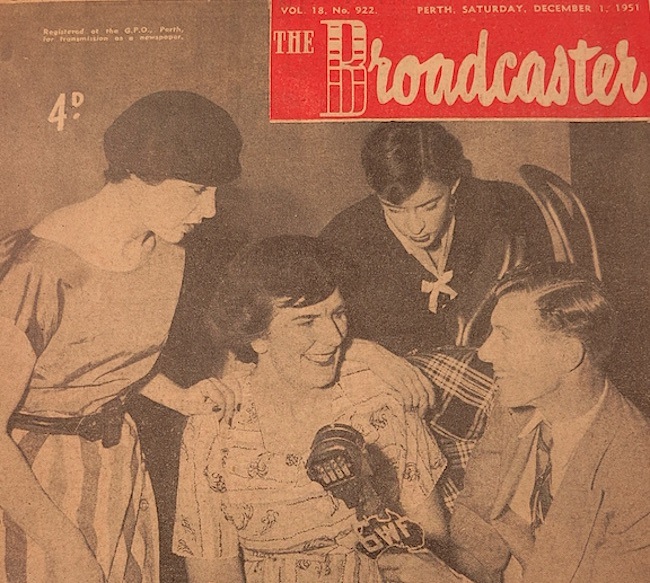
Meanwhile, Coralie was about to inject a large dose of entertainment onto the Perth scene with her series of reviews called ‘On The Beam’. For the inspiration acquired on her overseas trip was reflected in her musical comedy reviews at the Repertory Club. She excelled as writer, composer, producer and player of the brightest “home-grown” entertainment Perth had seen in many years in the sparkling show. Biddie Lawson (handled the costume design and the dance ensembles), brother James Condon was the compere and the cast included Hazel Lewis, Ian Millbank, Laurie Croisette, Harry Phipps, Gina Curtis, Kevin D’Alton, Noel de la Hunty, Lynne Clancy, Phillipa Howitt, Bernadette Pratley, Michael Cole, Robin Brennan, Toby Krantz, Judy Grace and many others, including several well-known ABC radio personalities. Harry Bluck and his orchestra provided the musical accompaniment. Rick Hearder played the Man in the Moon.
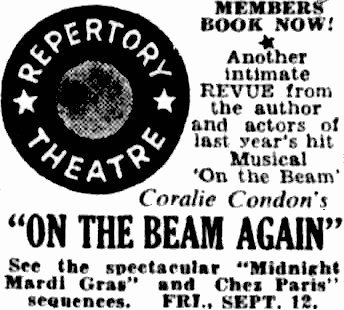
Coralie went on to produce six ‘On The Beam’ revue shows at the Repertory Club between 1951 and 1955, and was active in the Gilbert and Sullivan Society of Western Australia, which was established in 1951.
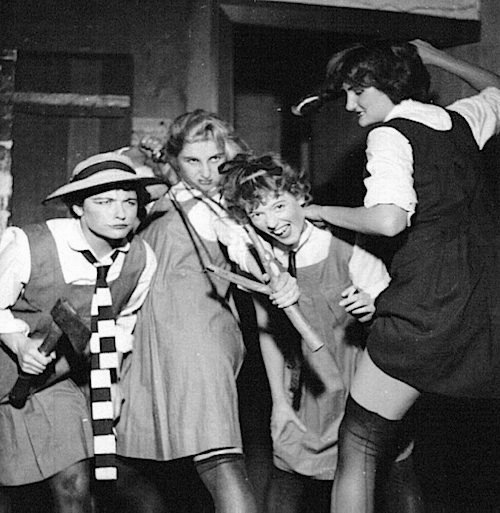
By this stage, Coralie had become the inveterate first-nighter, and often made two visits to a show. In the following years there would be few visiting theatrical personalities who had not found the Condon household a home away from home. She had a deep love for the theatre and could talk of it with the real knowledge of a back stager who had gained much practical experience filling the roles of prompt, lighting, props, dresser, stage hand and stage manager.
In April 1952, The Repertory Club presented ”Amphitryon 38,” a comedy by the French dramatist Jean Giraudoux, based on the Greek legend of Zeus’ rape of Alcmene, wife of Amphitryon.
In this case, the god Jupiter intrudes into the faithful marriage of the moral Alkmena (Coralie Condon) but discovers he must reckon with a woman far too intelligent to be led astray by passion, for she promised fidelity or suicide if she knowingly deceives her husband, and is thus determined to put marital fidelity before all other virtues, bringing forth this comment from the frustrated Jupiter: “She’s not a woman; she’s a fortress!”
The principle male was James Kemp, then aged 38, but when he fell ill, it required the stage manager, a much younger Rick Hearder (aged 21) to play the husband of the leading lady, Coralie (aged 36). Rick needed lots of make-up to appeared older, though his voice gave away his youth. Rick did this for two nights until the ailing James was back on deck.
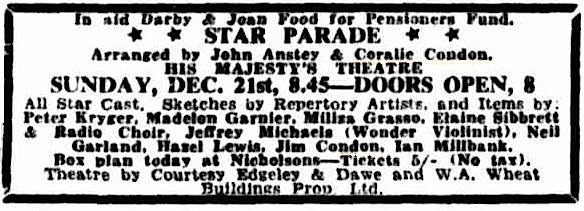
In December 1952, Coralie Condon and John Anstey arranged a “Star Parade” at His Majesty’s Theatre to aid the Darby Joan Food for Pensioners Fund. They found a sponsor and the theatre was kindly made available by Edgley & Dawe. There were sketches by the Repertory artists, a Radio Choir and various musicians.
The Festival of Perth was established in 1953.
In May 1953, The Repertory Club, in an experimental vein provided two plays on the one program. In the first half, the audience was required to only listen, as the cast sat and read the dream act known as ”Don Juan in Hell” (Act 3, Scene 2) from the four-act drama called “Man and Superman”, by George Bernard Shaw (written in response to calls for Shaw to write a play based on the Don Juan theme). Owing to this act being so long, it is often dropped from the play. In this case it was treated as a performance in its own right. Coralie Condon played the role of Ann Whitefield, a young woman who must decide between two men, to accept one as a guardian following the death of her father. In the second offering of the evening, the audience needed to watch the facial expressions of a different cast as they performed “Martine,” a play by Jean-Jacques, where the dialogue does not express the characters’ real attitudes. Instead, emotions are implied in gestures, facial expressions, fragments of speech, and silence.
In August 1953, Coralie Condon produced the musical “Anything Goes” with music and lyrics by Cole Porter, from the original book by Guy Bolton and P.G. Wodehouse. This was presented by the Repertory Club at the Assembly Hall. Brother James was one of the cast, along with friends in the acting fraternity, who included Gina Curtis, Hazel Lewis and Ronald Graham. The show received a most enthusiastic audience response.
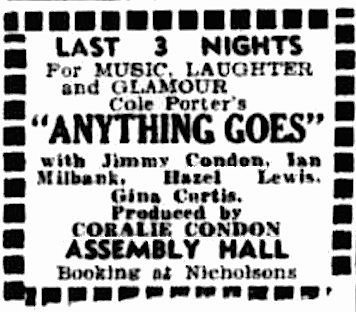
In late November 1953, Coralie produced the farce “Charley’s Aunt” at the Repertory Club with Ian Milbank in the title role. Sadly, the joy and merriment came to a sudden halt with the death of Coralie’s father on December 12th, 1953, at their residence, 22 St. George’s terrace, Perth. He was formerly of the Public Works Department (known previously as the State Implement Works), and a former Secretary of the Celtic Club. His Requiem Mass was celebrated in St. Mary’s Cathedral, which was then the Condon family parish church.
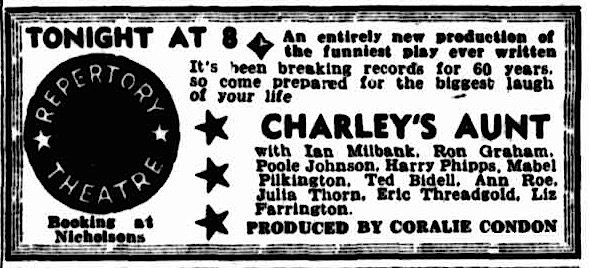
By February 1954, Coralie was gradually overcoming her grief to participate in the round of parties taking place, in the form of birthday celebrations and farewells.
For the Festival of Perth in March 1954, which was founded the year before by The University of Western Australia, Coralie was engaged as producer by The Company of Four to present “Ring Round the Moon” (by Jean Anouilh. translated by Christopher Fry). A season was staged at the Somerville Auditorium with a cast that included James Condon in the double part of the twin brothers-one wicked, one otherwise; also Nancy Lee, Dorothy Krantz, James Bailey, Hazel Lewis and Gina Curtis.
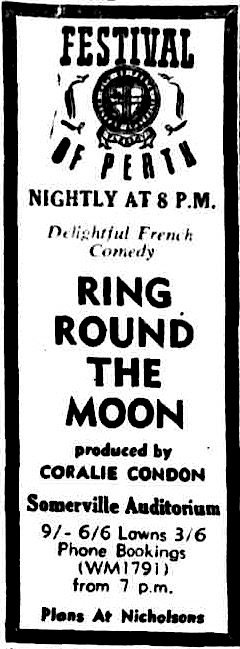
The ‘Company of Four’ was WA’s first semi-professional theatre company of local artists (they didn’t pay the actors to rehearse). It was set up after the second world war by Harold Krantz, Sol Sainken, Lily P. Kavanagh and Nita Pannell. John Birman, the Director of Adult Education was also most helpful.
Meanwhile, The Repertory Club was gathering contributions for its Building Fund, with an ongoing round of parties, called Night in Tahiti, Hawaii, Montmartre, the Lido and so forth. They used a huge thermometer to track their fund raising success. For the club was working towards the day when they could have their own purpose built theatre, which was to be the Playhouse Theatre, designed by Harold Krantz.
The Australian Elizabethan Theatre Trust was founded in 1954.
In June 1954, Coralie underwent an operation on her leg at St. John’s hospital, with her convalescing at the home of Harold and Dorothy Krantz (1912-1994). Harold Krantz was a successful architect whose firm donated the plans for the Playhouse, whilst his wife Dorothy was an icon of the theatrical scene in Perth of her time. Dorothy and Coralie became close friends, after Coralie was promoted to a small acting part opposite Dorothy, when she was playing the lead (during the 1942 Repertory Club production of “Morning Sacrifice”).
For the 1955 Festival of Perth, Coralie, aged 40, was engaged by The Company of Four and the Adult Education Board to produce “Mary of Scotland” by Maxwell Anderson at the Somerville Auditorium. The cast featured Dorothy Krantz, Gina Curtis and her brother James Condon.
In August 1955, Coralie produced the smash-hit stage comedy ‘The Man Who Came To Dinner’ for the Company of Four at the Capitol Theatre. Brother James Condon led the strong cast of 20 players.
In February 1956, Coralie adapted Oscar Wilde’s ‘Lord Arthur Savile’s Crime’ a collection of short semi-comic mystery stories starring Frank Baden-Powell (with whom she formed a partnership in 1967 which resulted in a thriving trade in theatre restaurants). Also in 1956, Coralie was called on to adjudicate at country drama festivals, during which time she met her lifelong friend Audrey Barnaby.
On Wednesday 22 August, 1956, The Repertory Club joined with the Company of Four, to become a fully professional theatre company called the National Theatre, following the move to The Playhouse at 3 Pier Street, Perth.
We would like to thank Audrey Long, Rick Hearder, Colin Nichol, Anthony Howes, David Hough, Colm O’Doherty, Murray and Rosalind Jennings, Sue Scrutton, Richard Ashton and Gordon McColl for their much valued help in assembling this story.
Some related links to our WA TV History web site…
- Coralie Condon – The First Lady of Western Australian Television
- Coralie Condon’s contributions to theatre and television in WA
- Coralie Condon’s 97th Birthday Party
- Coralie Condon’s 98th Birthday Party
- Coralie Condon’s 99th Birthday Party
- Coralie Condon’s Post TVW Reunion Get Together
- Coralie Condon welcomes old colleagues
It was only on the 14th of February of last year that her dearly beloved brother James passed away aged 90 years.
- Tribute to James Condon (1923-2014)
- The Perth National Theatre Company – Part 1 of 2
- The Perth National Theatre Company – Part 2 of 2







